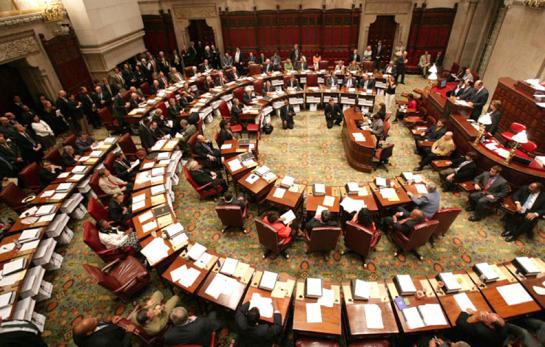
The NY State Senate Chambers (photo: Senate website)
New York's Constitution mandates a statewide referendum every twenty years on whether to convene a state constitutional convention. The time has come to begin preparing for the next referendum on Nov. 7, 2017, at which time voters will decide whether there is a convention the following April. Steps must begin to be taken now so that New Yorkers are ready to make an informed decision.
The referendum has two special democratic functions. First, to allow voters to bypass the legislature's gatekeeping power over constitutional amendment. The legislature has an institutional conflict of interest proposing amendments that would enhance the power of competing branches of government (e.g., the executive and judicial branches) or make itself more democratically accountable (e.g., legislative redistricting, ethics, transparency, term limits, and campaign finance).
Second, is to streamline a constitution. New York's current constitution is over 50,000 words long—approximately seven times the length of the U.S. Constitution. It is practically unreadable, encrusted with 225 amendments and numerous obsolete provisions. Conventions have proven better suited than legislatures at creating concise, readable constitutions.
American states have convened 236 conventions since 1776, including nine in New York. But the politics of convening one has become dismal due to opposition from legislatures, big business, and, especially since the 1970s, big labor. Unlike legislatures, powerful producer groups don't have an institutional conflict of interest. But they prefer to exercise influence through the legislature, where they have invested heavily in relationships and favorable institutional procedures. Sucked into this power vortex are many public interest groups who depend on the goodwill of these powerful political players to win legislative support for their primary institutional agenda, which rarely includes good government constitutional reform.
However, the politics of calling a New York convention are not hopeless. Thomas Jefferson, author of the U.S. Declaration of Independence and often credited as the inspiration for New York's periodic convention referendum, argued that America's state constitutions should be living documents, revisited every twenty years. Until the last fifty years, this vision had an extraordinarily rich history in New York.
New York's convention tradition can be reinvigorated—but only with an innovative educational campaign. Most New Yorkers don't even know they have a state constitution, let alone what's in it. As for state conventions, the vast majority of New Yorkers are unfamiliar with their history, function, and procedural safeguards.
New Yorkers wouldn't tolerate voting for a governor in such ignorance; neither should they tolerate such ignorance voting for a convention. To facilitate public understanding of the tradeoffs between legislature and convention initiated constitutional reform, the public deserves more than soundbite-sized yes and no ballot advocacy campaigns.
Governor Andrew Cuomo should create a commission composed of respected retired journalists to solicit, moderate, and publish public feedback on whether New York should convene a convention. This should include webcast public hearings and a public website modeled after the public commenting system used for regulatory proceedings. When campaigning for governor in 2010, Cuomo announced support for convening a convention and a commission to prepare for it, but his proposed commission was to convene after rather than before the referendum and to make rather than exclusively solicit recommendations.
High school debate teams should be invited to debate the question as written in New York's Constitution: "Shall there be a convention to revise the constitution and amend the same?" High school history and government classes should invite students to vote on the question in mock elections.
New Yorkers should have an opportunity to learn about their rich convention history via a televised documentary and museum exhibit. Events during 2017 on New York State History Day and Constitution Day could contribute to this effort.
Think tanks, museums, and other nonprofits should conduct webcast pro-and-con discussions about convening a convention. All the major viewpoints should be given a thorough public airing.
Media outlets should assign a reporter to cover the convention referendum just as they assign reporters to cover major statewide elections. They should also survey the public about its knowledge of New York's state constitution and convention process so that key areas of ignorance can be publicly exposed and addressed.
In our day-to-day lives, we are as oblivious to the impact of constitutions as to the impact of the air we breathe. But a well-designed, up-to-date state constitution built on an effective updating mechanism is as vital to our body politic as air to our physical body.
Nov. 7, 2017 may seem like a long way off. But for the public to be able to make a well-informed vote on that date, preparations should begin immediately.
***
J.H. Snider, the president of iSolon.org, is the editor of The New York State Constitutional Convention Clearinghouse and author of Does the World Really Belong to the Living? The Decline of the Constitutional Convention in New York and Other US States, 1776–2015.




